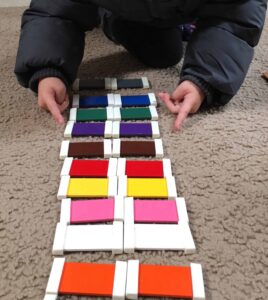
Choosing the right preschool for your child a can be a big job. There are many factors to consider. Full day or half day? Five days a week or three days a week? Health and safety guidelines? A traditional preschool setting or, maybe, something a bit outside of the box?
How Is a Montessori Preschool Different from a Traditional Preschool?
Most quality preschools have the same end goal of providing a safe, healthy, and engaging environment for your child, while promoting growth and independence in a developmentally appropriate manner. The way in which each school may go about reaching this goal could look vastly different.
The Montessori Method utilizes specific methods, first developed by Italian doctor and educator Maria Montessori around the turn of the twentieth century. It uses a child-centered approach to education, promoting the view that children are eager and capable learners, especially when provided with the right materials and opportunities. The Montessori Method helps to prepare a child for all aspects of life through a variety of methods and experiences. Many of the methods utilized in the Montessori Method may vary greatly from those used in a traditional preschool. It is these differences that make the Montessori Method an appealing alternative. The following takes an in-depth look at some of the key contrasts between a traditional preschool and a Montessori Preschool.
Student Interests
Traditional Preschool: In a traditional preschool classroom a teacher may plan lessons weeks, or even months, in advance. It is more important to stick to timelines and manuals than to follow the lead of the child, even if it is at the expense of a quality educational experience. Lesson plans are completed and reviewed weeks prior to delivery, making it difficult to modify based on the needs and interests of the students.
Montessori Preschool: The Montessori approach emphasizes flexibility and choice. Students are viewed as trusted and skilled individuals who can make informed decisions regarding their own learning. Perhaps the teacher had planned to spend the morning using wooden popsicle sticks to construct 2D shapes. If the teacher finds that the students are more interested in using the sticks to build a catapult, that is the path that is followed. The teacher may guide the conversation around early properties of physics, such as how the length and height of the catapult effects power. Because it is student led, the lesson is far more meaningful and interesting.
Materials
A traditional preschool teacher may not have been trained in fully understanding the importance of an orderly and appealing environment full of relevant materials. Hands on materials may be pushed toward the background to concentrate on digital materials, such as tablets or computers.
Montessori Preschool: Materials are at the core of the Montessori Method. It was the vision of Dr. Montessori to create educational materials perfectly suited to the needs of developing children. All Montessori materials are thoughtfully designed meet a number of objectives, including; self-correction, sensory engagement (opportunities to see, hear, and touch), variety of texture (materials made of wood, glass, ceramic, fabric, metal), and practicality. Not only are the actual materials of importance, but also how they are accessed and organized within the environment. Materials are typically arranged in an aesthetically appealing manner to promote a sense of peace and organization. All materials are easily accessible and can be utilized as seen fit by the student throughout the learning process.
Student Groupings
Traditional Preschool: Students are likely to be grouped by age rather than developmental range. As an example, all children between the ages of three and four will be in one classroom, while all children between the ages of four and five may be in another classroom. Little consideration is made for where a child may fall developmentally. It would not be uncommon for a three-year-old and a five-year-old to be on the same developmental level or share some of the same interests. A traditional teacher is rarely given the opportunity to account for such discrepancies.
Montessori Preschool: Teachers are given the opportunity to observe students to determine the most appropriate student groupings based on individual developmental levels, needs and interests. This could result in a three-year-old and a five-year-old being placed in the same environment. This might best meet the developmental needs of both students, as well as provide valuable social experiences, including opportunities for cooperation and leadership roles.
Which Preschool is Right for Your Child?
Is your child a hands-on learner? Is your child inquisitive? Do you want to foster a sense of independence, as well as strong self-confidence within your child? If the answer to any, or all, of these questions is “yes”, then a Montessori Preschool may be the perfect fit for your family.

